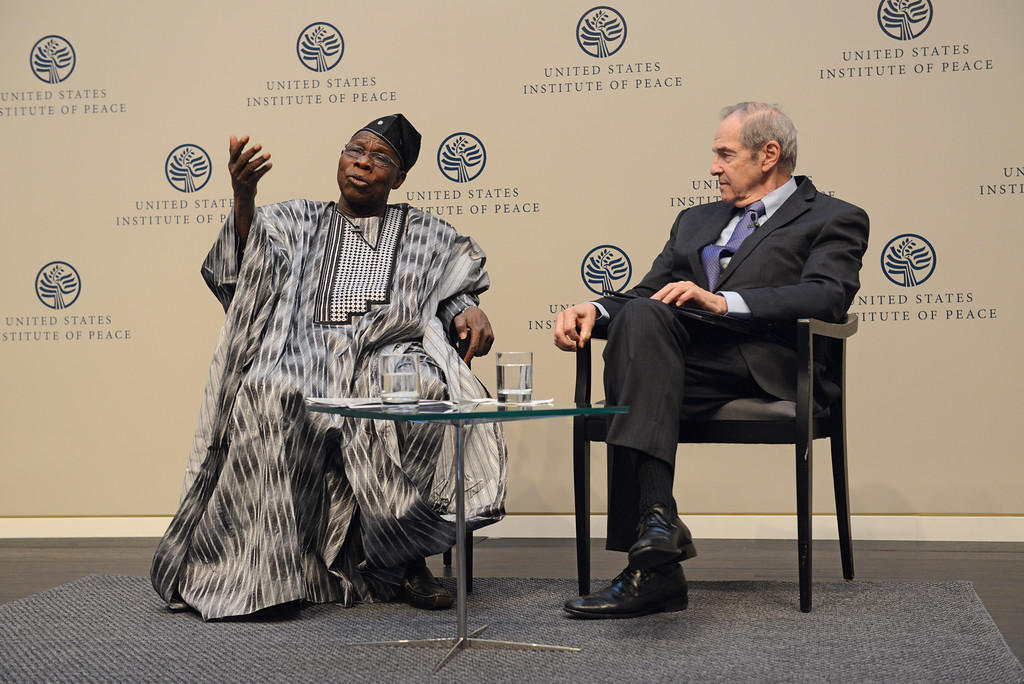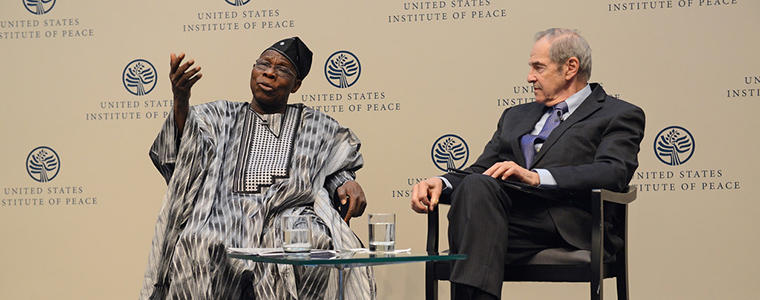Former Nigerian President Olusegun Obasanjo, who led his country’s return to civilian democratic government after decades of military rule, said Africa’s traditions of consultation with elders and forms of peer review can promote public accountability and provide a way for controversial leaders who are fearful of giving up power to step down in favor of a future of statesmanship.

“Governance-reform and capacity-building programs, for example, are apt to look everywhere but within,” Obasanjo told an audience at the U.S. Institute of Peace on April 23. Such initiatives make a mistake by not “rigorously” engaging those responsible for a country’s problems “as stakeholders in the remediation process.”
“For a change, let us move away from the melancholic issue of what is wrong with Africa.”
Obasanjo sets an example for governance as “one of the world’s leading statesmen,” said Princeton Lyman, a former U.S. ambassador to Nigeria and special envoy who now serves as a senior advisor at USIP, told the audience. In the runup to the country’s recent historic election, in which an opposition candidate won against an incumbent president for the first time, “there was no stronger voice … for a successful, a peaceful and a just election than President Obasanjo,” Lyman said.
During Obasanjo’s two terms as president from 1999 to 2007, which followed a period of imprisonment under the repressive rule of General Sani Abacha, “he instituted a number of economic reforms,” Lyman said.
“He brought Nigeria into the Extractive Industries Transparency Initiative (EITI). And he won international support for a debt-relief package that lifted a $30 billion debt off of Nigeria’s shoulders,” Lyman said. “As a diplomat, he reached agreement with all of Nigeria’s neighbors on the difficult maritime border issues that opened up for all of the countries of West Africa the opportunity to benefit from the rich oil and gas reserves offshore.”
Obasanjo has helped end wars or other crises in multiple African nations, said Lyman, who recalled discussions of various African peace efforts at the leader’s farm at Ota outside of Lagos. And the president led in creating the African Union in 2000.
Noting that Africa accounts for 20 percent of the world’s land and 15 percent of its population, and that its collective GDP is forecast to grow about 5 percent, Obasanjo cited analysts who see it as ripe for opportunities and said the continent must aim higher, to double-digit growth.
Despite conflicts plaguing parts of Africa, such as that in the continent’s newest nation of South Sudan, trends indicate a “slow but steady consolidation of democracy,” with a spreading of the norms and institutions needed to support free economic and political systems, Obasanjo said.
“For a change, let us move away from the melancholic issue of what is wrong with Africa,” Obasanjo said. “If we are truly committed to invigorating conversations about an Africa-focused, Africa-led and Africa-driven framework for substantive self-determination and sustainable development, it is important to rethink and reframe how we situate Africa at the center of inquiry.”
'Twilight Apprehensions'
One element that would help is the kinds of structures and institutions, such as presidential libraries or advising opportunities, that have become standard in the U.S., said the former head of state, who was speaking under the auspices of the Leadership Enterprise for African Development (LEAD), a joint venture of the Yale Council on African Studies and the Institute for Research on African Women. Such arrangements would “ease the twilight apprehensions” of leaders who might otherwise be reluctant to leave office and could be used to capitalize on their leadership expertise once they do step down, he said.
Obasanjo said Togo, the Democratic Republic of Congo and Gabon are among countries with leaders reluctant to give up power for fear they might “land in prison or in the grave.” And yet many leaders could offer valuable knowledge and insights after they leave office, despite the controversies that might have dogged them while at the helm, he said.
“What if African statespersons made a coordinated effort, measured against concrete benchmarks, to strategically learn from their own scorecards to help implement homegrown solutions for leadership, governance and succession in government, business and civil society sectors?” Obasanjo said.
“What if African leaders methodically reflected and drew upon their steep learning curves and, further, to help inform blueprints with which to advance the consolidation of equitable, democratic transitions, among other priorities?”
Addressing the instability across the Sahel region, Obasanjo said in most cases it’s driven by exclusion and marginalization of parts of the population and the failure of governments to pay heed and to provide basic services, he said. That leads to frustration, agitation and, left unaddressed, to violence and its extreme form, terrorism.
Institutions that can resist such deterioration are built gradually, he said. The recent presidential election in Nigeria, in which President Goodluck Jonathan conceded to his opponent, Muhammadu Buhari, who takes office next month, “has moved Nigeria one very important step up in our democracy,” Obasanjo said.
USIP Acting Executive Vice President Bill Taylor said the elections were “inarguably, a milestone for Nigerian and African democracy.”
The results “opened new prospects for Africa’s demographic and economic giant to strengthen governance [and] reverse the spread of the Boko Haram insurgency,” Taylor said. USIP works in Nigeria with government, civil society and academia to help address governance challenges through education, grants and other resources.
Nigeria’s presidential election may help point the way for other African nations facing either nationwide balloting or crises of leadership.
“It’s good not only for Nigeria,” said Obasanjo. “It’s good for Africa.”
